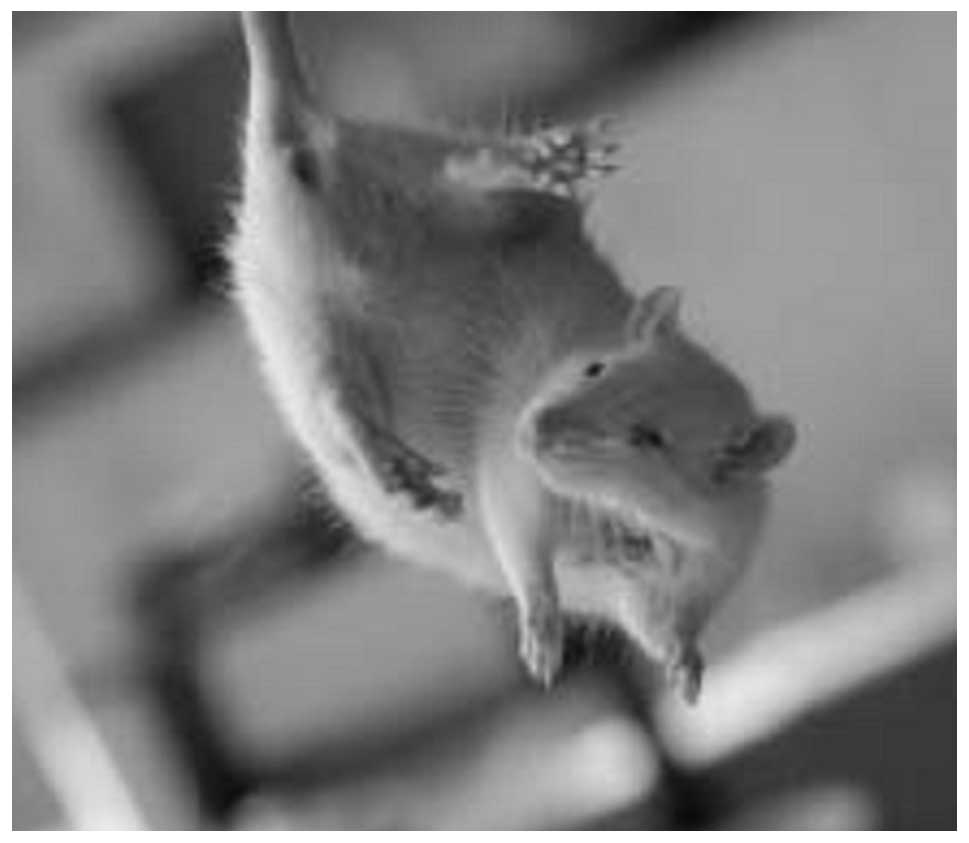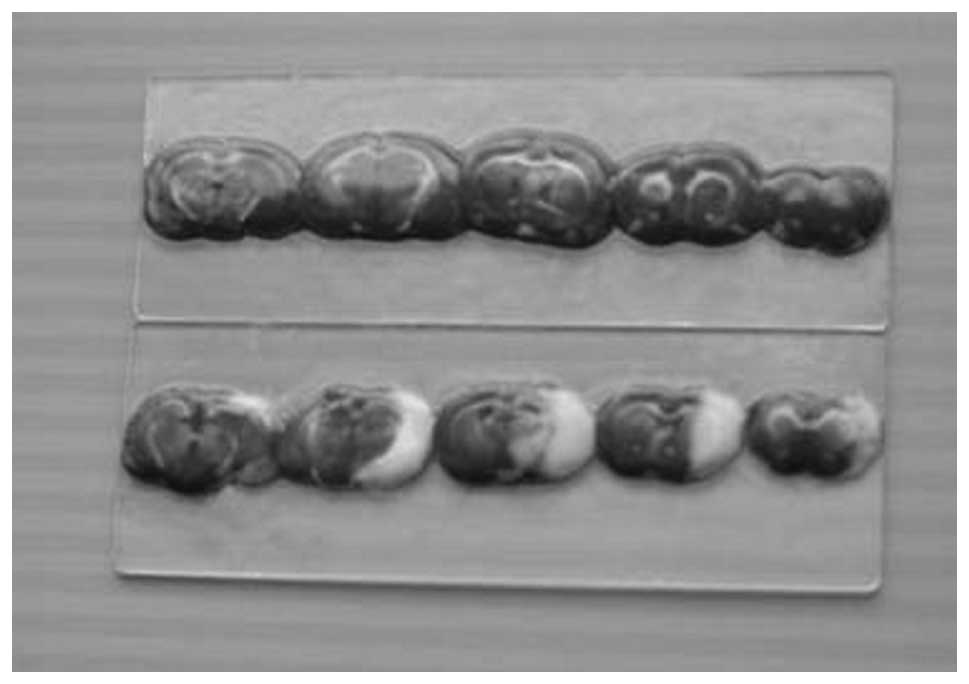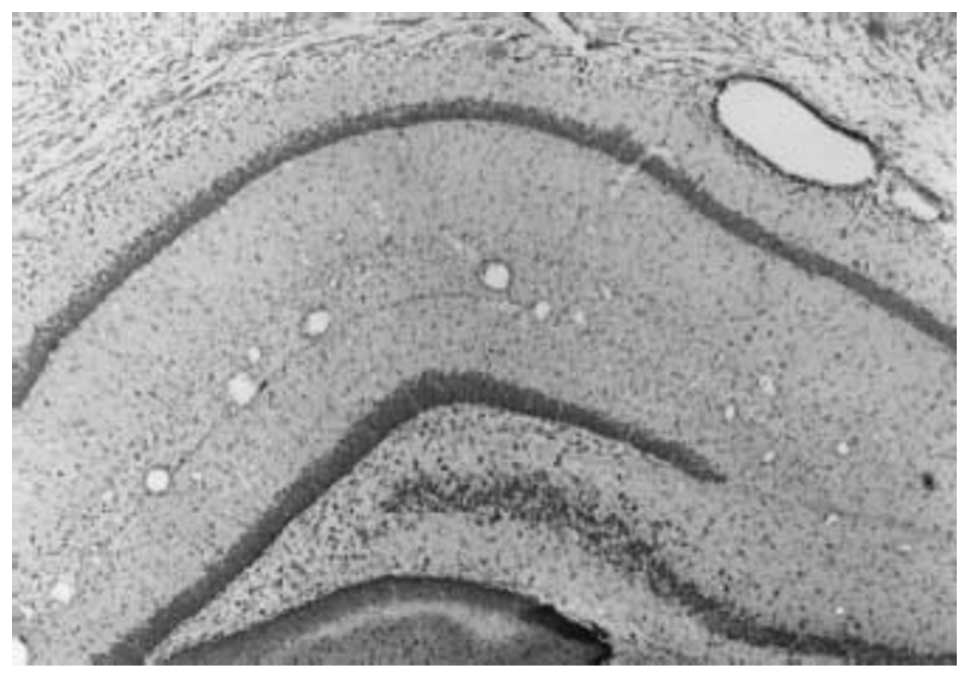|
1
|
Simpkins JW, Wen Y, Perez E, Yang S and
Wang X: Role of nonfeminizing estrogens in brain protection from
cerebral ischemia: an animal model of Alzheirmer’s disease
neuropathology. Ann N Y Acad Sci. 1052:233–242. 2005.PubMed/NCBI
|
|
2
|
Buga AM, Bălşeanu A, Popa-Wagner A and
Mogoantă L: Strategies to improve post-stroke behavioral recovery
in aged subjects. Rom J Morphol Embryol. 50:559–582.
2009.PubMed/NCBI
|
|
3
|
Fisher M, Feuerstein G, Howells DW, et al;
STAIR Group. Update of the stroke therapy academic industry
roundtable preclinical recommendations. Stroke. 40:2244–2250. 2009.
View Article : Google Scholar : PubMed/NCBI
|
|
4
|
Matsui T, Arai H, Yuzuriha T, et al:
Elevated plasma homocysteine levels and risk of silent brain
infarction in elderly people. Stroke. 32:1116–1119. 2001.
View Article : Google Scholar : PubMed/NCBI
|
|
5
|
Lloyd-Jones D, Adams R, Carnethon M, et
al; American Heart Association Statistics Committee and Stroke
Statistics Subcommittee. Heart disease and stroke statistics - 2009
update: a report from the American Heart Association Statistics
Committee and Stroke Statistics Subcommittee. Circulation.
119:480–486. 2009. View Article : Google Scholar
|
|
6
|
Dittmar M, Spruss T, Schuierer G and Horn
M: External carotid artery territory ischemia impairs outcome in
the endovascular filament model of middle cerebral artery occlusion
in rats. Stroke. 34:2252–2257. 2003. View Article : Google Scholar
|
|
7
|
Longa EZ, Weinstein PR, Carlson S and
Cummins R: Reversible middle cerebral artery occlusion without
craniectomy in rats. Stroke. 20:84–91. 1989. View Article : Google Scholar : PubMed/NCBI
|
|
8
|
Boyko M, Zlotnik A, Gruenbaum BF, et al:
An experimental model of focal ischemia using an internal carotid
artery approach. J Neurosci Methods. 193:246–253. 2010. View Article : Google Scholar : PubMed/NCBI
|
|
9
|
Durukan A and Tatlisumak T: Acute ischemic
stroke: overview of major experimental rodent models,
pathophysiology, and therapy of focal cerebral ischemia. Pharmacol
Biochem Behav. 87:179–197. 2007. View Article : Google Scholar : PubMed/NCBI
|
|
10
|
Koizumi J, Yoshida Y, Nakazawa T and
Ooneda G: Experimental studies of ischemic brain edema. I: a new
experimental model of cerebral embolism in rats in which
recirculation can be introduced in the ischemic area. Jpn J Stroke.
8:1–8. 1986.
|
|
11
|
Ma J, Zhao L and Nowak TS Jr: Selective,
reversible occlusion of the middle cerebral artery in rats by an
intraluminal approach. Optimized filament design and methodology. J
Neurosci Methods. 156:76–83. 2006. View Article : Google Scholar
|
|
12
|
Durukan A, Strbian D and Tatlisumak T:
Rodent models of ischemic stroke: a useful tool for stroke drug
development. Curr Pharm Des. 14:359–370. 2008. View Article : Google Scholar : PubMed/NCBI
|
|
13
|
Prieto R, Carceller F, Roda JM and
Avendaño C: The intraluminal thread model revisited: rat stain
differences in local cerebral blood flow. Neurol Res. 27:47–52.
2005. View Article : Google Scholar : PubMed/NCBI
|
|
14
|
Cheung JS, Wang E, Lo EH and Sun PZ:
Stratification of heterogeneous diffusion MRI ischemic lesion with
kurtosis imaging evaluation of mean diffusion and kurtosis MRI
mismatch in an animal model of transient focal ischemia. Stroke.
43:2252–2254. 2012. View Article : Google Scholar : PubMed/NCBI
|
|
15
|
Chauveau F, Cho TH, Riou A, et al: Does
acute behavioral testing reflect successful ischemia in rats with
transient middle cerebral artery occlusion? Int J Stroke.
7:465–472. 2012.PubMed/NCBI
|
|
16
|
Bederson JB, Pitts LH, Tsuji M, Nishimura
MC, Davis RL and Bartkowski H: Rat middle cerebral artery
occlusion: evaluation of the model and development of a neurologic
examination. Stroke. 17:472–476. 1986. View Article : Google Scholar : PubMed/NCBI
|
|
17
|
Nagaoka A, Suno M, Shibota M and Kakihana
M: Effects of idebenone (CV-2619) on neurological deficits, local
cerebral blood flow, and energy metabolism in rats with
experimental cerebral isehemia. Nihon Yakurigaku Zasshi.
84:303–309. 1984.(In Japanese).
|
|
18
|
Tatlisumak T, Takano K, Carano RA, Miller
LP, Foster AC and Fisher M: Delayed treatment with an adenosine
kinase inhibitor, GP683, attenuates infarct size in rats with
temporary middle cerebral artery occlusion. Stroke. 29:1952–1958.
1998. View Article : Google Scholar : PubMed/NCBI
|
|
19
|
Hattori K, Lee H, Hurn PD, Crain BJ,
Traystman RJ and DeVries AC: Cognitive deficits after focal
cerebral ischemia in mice. Stroke. 3l:1939–1944. 2000. View Article : Google Scholar
|
|
20
|
Airavaara M, Shen H, Kuo CC, et al:
Mesencephalic astrocyte-derived neurotrophic factor reduces
ischemic brain injury and promotes behavioral recovery in rats. J
Comp Neurol. 515:116–124. 2009. View Article : Google Scholar : PubMed/NCBI
|
|
21
|
Boyko M, Ohayon S, Goldsmith T, et al:
Morphological and neuro-behavioral parallels in the rat model of
stroke. Behav Brain Res. 223:17–23. 2011. View Article : Google Scholar : PubMed/NCBI
|
|
22
|
White BC, Sullivan JM, DeGracia DJ, et al:
Brain ischemia and reperfusion: molecular mechanisms of neuronal
injury. J Neurol Sci. 179:1–33. 2000. View Article : Google Scholar : PubMed/NCBI
|
|
23
|
Kawamura S, Li Y, Shirasawa M, Yasui N and
Fukasawa H: Reversible middle cerebral artery occlusion in rats
using an intraluminal thread technique. Surg Neurol. 41:368–373.
1994. View Article : Google Scholar : PubMed/NCBI
|

















